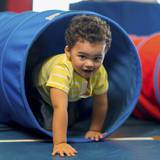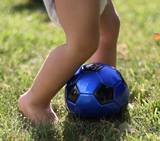Summer’s on the horizon – is your family water-safe?
|
Water is an essential part of Kiwis identity and many under 5's grow up spending their holidays at the beach, fishing off the rocks, swimming in a pool or learning how to drive a boat. Yet according to Safekids Aotearoa, drowning is the leading cause of injury-related death among children between 1 and 4 years old.
|
You might also be interested in ...
Benefits of recreational gymnastics
Taking part in recreational gymnastics from a young age comes with many benefits for toddlers and preschoolers. As well as helping them to develop their co-ordination and build their self-esteem, it’s all about having fun and focusing on interactive play and their social well-being. Preschool gym classes encourage toddlers and preschoolers to be active in a safe, monitored environment.
Importance of exercise for kids under 5
We all know that physical activity is important for young children for their whole development, building their confidence, strength and improving balance. Being active is what kids are born to do! Find out more about the importance of exercise for preschool kids.







Importance of water safety
Water is an essential part of Kiwis identity and many under 5's grow up spending their holidays at the beach, fishing off the rocks, swimming in a pool or learning how to drive a boat.
Yet according to Safekids Aotearoa, drowning is the leading cause of injury-related death among children between 1 and 4 years old.
Karla McCaughan, Swim School Quality Services Manager for YMCA Auckland says, “Teaching preschoolers about swimming and water safety is a cause very close to my heart.
Most of the under-five drownings in New Zealand happen when children find water unattended.
I truly believe that if we work collectively towards giving water safety the same priority as road safety, we can make a difference.
We don’t allow a preschooler to cross the road unattended or at their own command, so let’s teach our young ones that they can only go in water when a grown up is with them and that they only go in water when an adult says they can.
At the end of the day, there is no better way to keep your child safe around water than through constant and vigilant supervision.
But the benefits of participation in a good learn-to-swim programme are so valuable parents shift from an ‘I can’t afford this’ to a ‘can I afford not to?’ mentality around teaching these essential skills to children.”
10 tips for swimming safe this summer
Karla shares ten tips for swimming safer this summer.
1. Constant supervision
Make sure you actively supervise the children swimming at all times. It can take a matter of seconds for a child to get into trouble in water.
Keep your eyes on them and if you can’t keep them within sight and within reach, have them stay out of the water until you’re able to go in with them.
It can be a good idea to have a designated supervisor for parties and family events.
Parents can sometimes become confused as to who is watching the kids so by making someone responsible we can ensure that all children are supervised at all times.
2. Teaching hesitation
Teach your children that they are not allowed to play in, on or around water unless you are with them.
99% of drownings in this age group happen when children “find” water whilst unattended.
Teach your children to ask themselves “Have I got an adult with me?”
3. Learn to swim
Summer is almost here – make sure the kids and yourself are confident and competent in the water.
Head to your local pool to practice and book the kids in to swim school lessons.
Choose an AUSTSWIM Recognised Swim Centre or Swimming New Zealand Quality Swim School.
These Swim Schools are guaranteed to deliver a programme that employs teachers with an industry recognised qualification.
A good Swim School will deliver a programme that not only teaches swimming but basic water safety and survival skills also.
4. Education is key
Don’t scare your kids but make sure they are truly aware of the dangers of water.
Have an open chat with your children about what they would do if they saw a friend struggling in the water.
It is important that they know not to go in the water to try and rescue someone else.
Talk about what items could be thrown to someone in difficulty to help them float, like a ball or a chilly bin lid.
Make sure they know to tell an adult immediately.
5. Identifying water hazards around the home
Work as a family to identify all water hazards in and around your home.
There are many items that may present a drowning threat. Things like buckets, even pet bowls, anything that can contain water.
Always stay with children during bath time and minimise distractions like answering the phone.
Empty the bath tub after use and keep all plugs out of reach.
6. Water toys are not a safety device
Never rely on water rings or inflatable toys for safety. Toys are great for having fun with when supervised swimming but will not protect your child from drowning.
They must also be removed from the pool when not in use; this may help prevent a toddler accidently falling in while trying to recover a toy.
7. Home pool safety
Make sure if you or your friends own a pool that it matches the safety standards and that it is safely fenced with securely lockable gates.
Never leave anything that your child can climb on by the pool fence, ensure the gate swings back to closed after being opened and have a child proof latch.
Always empty and store paddling pools after use.
8. Beach safety
As soon as you get to the beach, look around and familiarise yourself with the swimming area.
It’s also a great time to remind the kids of what is around them and even outline a ‘swim zone’ that they shouldn’t swim past or beyond.
If it is a beach with red and yellow flags, make sure they only swim in that area. This is where the life guards patrol, and indicates the safest place to swim on that beach.
9. River safety
If you are picnicking by a river or water hole be aware of the potential dangers. More people drown in rivers in NZ than anywhere else.
The look of rivers can be deceptive with water often moving faster than it appears.
Pick your swimming spot carefully and watch for hidden objects like logs and rocks.
10. Boating safety
Children should wear life jackets at all times when on a boat, at the wharf or near any body of water.
The life jacket must be the right size, tight fitting and worn correctly.
Accompanying adults should wear life jackets, not only for their own protection but to set a good example.
Source: This article was kindly written for us by YMCA Auckland.